2018 Update: Weather here in the Pacific Northwest isn’t nearly as strange as what our friends in Ireland or on the East Coast are dealing with. What I’m seeing is actually pretty typical for early March in the Pacific Northwest: a back and forth between blustery, cold, wintery weather and drizzly, mild spring weather.
In my yard, brassicas are bolting and blossoms are opening on my plum trees, which feels perhaps just a touch early but not particularly odd. Given that the sky just ripped apart, I think we’re doing pretty well out here.
March 20 is official start of spring, but winter and spring tend to struggle for control in the weeks leading up to – and sometimes following – the Vernal Equinox. This is normal. March is always a transition time and, like any edge, there’s a lot of excitement to be had.
My gut based on nothing more than a dozen years gardening suggests that we will probably end up with a warm summer this year, but there will be weeks of soggy detours before we get there. Your best bet this year is to seize opportunities to get outside and sow your cool-season crops like peas and greens as you see them. Little pockets of sunshine are worth savoring. Just don’t rush to work or turn or amend soil that is still very wet.
If you are very committed to early spring gardening, get your low tunnels set up soon (this helps with warming and drying soil). And, until the weather is a touch more consistent, just enjoy being an indoor gardener – there are plenty of seeds that want to be started right now!
Printable At-A-Glance Grow Guide!
If you like your Gardening To Do Lists simple and direct, you’re in luck! Just click the image below to download the March At-A-Glance Grow Guide as a printable PDF.
Or, continue reading for the full details on everything there is to do in the garden this month.
Plan and Purchase
If you haven’t finalized your seed order, get on it. Great seed houses do actually run out of popular varieties of seed. If the big world of vegetables seeds is still a bit intimidating, here’s a few resources to help:
- How To Pick Your Vegetable Seeds Without Going Crazy
- Seed Selection Made Very, Very Simple
- All the Seed Terminology You Need To Know
- Is Cheap Seed Hurting Your Garden? Germination Rate, Vigor, and Why You Should Care
- Plant Sex: Open Pollinated, Hybrid and GMO Seeds
Don’t Forget To Order Perennials
Nurseries are getting all their fruit trees and perennials in right now, and companies like Raintree are shipping bareroot trees as fast as they can, but selection is going fast so get on it if you are planning on a fruit or nut tree order this spring.
- Asparagus Crowns – I grow Jersey Knight, a high yielding, easy to grow variety.
- Bare Root Fruit Trees – One day I will figure out how to grow all the fruit. If you don’t get your bareroot order in soon you’ll have to wait until Fall.
- Bare Root Fruit Bushes, Rhubarb, Cane Fruit and Vines
- Seed Potatoes – If you haven’t ordered your seed potatoes yet, really a move on. My absolute favorite variety of potato is French Fingerling, and Yukon Gold is a popular choice for a reason. Most garden centers and even many big box and grocery stores are offering seed potatoes at this time of year if specific variety is less critical to you.
- Garlic – yes, you should have done this last fall. But if you didn’t get to it, stick a few cloves of seed garlic in the ground. They’ll do something.
Start Indoors
Pretty much everything can be started now if you have a good grow light. This year I have most of my seeds under this T5 grow light but I’m also trialing this cheap LED grow light.
New to starting your own seeds? These resources may help:
- Seed Starting 101: Key Components For Healthy Seedlings
- Seed Starting 101: A Step-by-Step Visual Guide To Growing Seedlings At Home
- Seed Starting 101: Up-Potting
- Seeds Started Under Lights vs On A Windowsill
- Which Seed Starting Supplies Are Worth It (And Which Aren’t)
Brassicas
Pretty much the same as last month. All brassicas can be started under lights, or you can wait a month and sow directly outside. Slugs decimate my direct-sown spring plantings so I prefer to transplant.
- Broccoli – early varieties should be started under lights early this month for planting out under a cloche at the beginning of April. All around, I like Belstar. It’s a solid broccoli all year round. Some seed companies do broccoli blends, which are useful to home gardeners who don’t want to worry about succession planting. Territorial offers a good one.
- Brussels Sprouts – early varieties should can be started under lights early this month for planting out under a cloche at the beginning of April. I prefer Brussels Sprouts as a cool season crop, and will start them in mid-June to mature from late-September for harvest through fall and winter.
- Cabbage – Be careful about variety selection here. You want an early cabbage with a maturity date of around 60-80 days. Farao is great. The really long maturing cabbages are better suited for fall. Start under lights early this month for planting out under a cloche at the beginning of April.
- Cauliflower – A bit more finicky than other brassicas, give special attention to your cauli seedlings with consistent moisture and lighting and regular organic feeding or slow release fertilizer in the grow medium. Early varieties should be started under lights early this month for planting out at the beginning of April. Snowball and Romanesco have done very well for me.
- Kohlrabi – I find this this crop easier to grow for fall (use a large hardy kohlrabi like Kossak or Superschmelz for that) but it’s so delicious it’s worth a bit of fiddliness.
- Kale and Collards – Both these crops germinate and grow well, even in cool soils, so it’s not necessary to start these indoors. You can, but you can also direct seed. A cloche will help speed germination. Champion is a fine vates-type Collard, and lacinato kale is a staple in my garden.
Nightshades
- Tomatoes – Early March is a great time to start tomatoes indoors. I’m still pretty well stocked on canned tomatoes, so I’m focusing on cherry-types, a few early slicers, and some random heirloom-types I had in the bottom of my seed bin this year.
- Hot & Sweet Peppers – these are more tender than tomatoes, so standard practice is to start them a few weeks after tomatoes. I find it’s just easier to start them at the same time and up-pot them in a gallon pot so they have the longest grow time, but I have a greenhouse for hardening them off through that awkward “cool May and June” time. If you don’t, you may want to start your peppers towards the middle or end of the month. Remember to use cool-climate cultivars. In the Maritime Northwest, I have decent results with King of the North pepper and very good yields on small, hot peppers. Cherry Bomb was great for me last year.
- Eggplant – Start at the end of the month unless you have a greenhouse or someplace very advantageous to transition your eggplants. These plants are pretty tender – they’ll do better if the nights are in the 60s when they go out to the garden. Little Finger and other small types yield better in the Northwest than big globe types.
Leafy Greens and Herbs
- Swiss Chard – Start anytime, or just sow outside to a cloche. They’ll be fine if you don’t need chard in April or something.
- Salad Greens – Sow salad greens! Once a month at least for continuous harvest! Outside, your seeds will take quite awhile to germinate, so if you love your greens, sow a few pots of lettuce under lights along with your tomatoes.
- Hardy Herbs – Parsley, chives, fennel, chervil, oregano, dill, mint, sorrel, marjoram, lemon balm, pansies etc. can be started under lights or direct sown if you have a little patience.
Other Stuff
- Onions – Too late to start from seed I’m afraid, but you can buy plants from your local nursery or a specialty supplier like Dixondale.
Sow & Plant Outside
Remember that any veggie sown or transplanted out in March will be happier and give better results under a vented cloche kept in place through mid-April or May. Make sure to prevent heat build-up by venting during the day, especially if it’s sunny! Keep the ground moist enough to assist germination.
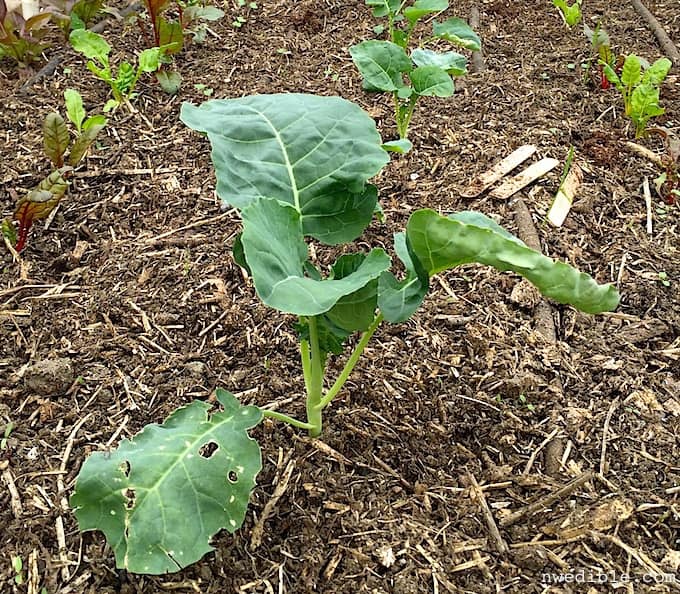
Seeds & Starts
- Peas & Favas – Sow any time!
- Salad Greens – Spinach, mustards, arugula, Asian greens and cress can be sown directly for baby salad greens. If you started greens last month under lights, harden them off, then transplant out.
- Carrots, Parsnips & Root Parsley – If you have fine, loose, sandy soil these will probably do fine sown about mid month. If your ground is heavier and holds water I’d wait several more weeks until it’s drier and you can rake the first several inches of soil to a nice fluffy consistency without clods before sowing the root crops.
- Brassicas started last month – should be ready to transplant to a protected area (cloched, etc.) by mid month.
- Radishes – Can be sown out directly. It works well to intercrop radishes and carrots or parsnips.
- Turnips & Rutabagas – I don’t bother with rutabagas in spring. For me they are a purely fall-winter crop. Spring turnips are lovely though. Harvest them little before maggots tunnel through them.
- Beets – Can be sown out directly towards the end of the month, or now if you have a nice low-tunnel or cloches bed ready.
- Onion Starts – Plant now. I tend to just deliberately plant a bit too close and eat the thinnings.
- Potatoes – The gardener tradition is to sow potatoes on St. Patrick’s day (March 17th). That works just fine most years. For best results, chit your potatoes before sowing fairly deep in loose soil and cover with plenty of insulating straw, leaves, etc. – to protect them in case of with a late frost
Perennials

As long as the ground isn’t frozen or waterlogged, bare root or potted fruiting trees, bushes and perennials can be planted out anytime.
The sooner you can get them in, the better. Don’t let roots of bare root perennials dry-out or freeze. If you receive an order of bare-root plants and you can’t get them in the ground within a few days, keep the roots moist and heel them in a big pile of mulch to protect them.
- Bare root fruit trees – these should be put into previously prepared ground while still dormant.
- Bare root fruit bushes (currants, gooseberries, blueberries, etc.) – Everyone loves blueberries, but try white currants for a slightly less common but delicious and attractive landscaping fruit.
- Bare root cane fruits (blackberries, raspberries, etc.) – I’m a big fan of Triple Crown Thornless Blackberry.
- Asparagus crowns – check out my tips for better soil for asparagus before planting.
- Rhubarb crowns – these can be had by dividing established plants. They are practically unkillable.
- Horseradish roots – these can be invasive! It’s a good idea to plant them in a very large container sunk into the ground to control their roaming. I didn’t so let’s see how that works out, shall we?
Harvest
The goal of almost any vegetable that’s survived an entire growing season and gone through winter at this point is to make seed as soon as is reasonable. Expect kale to make florets (delicious with garlic, chili and lemon!), and for most of the root vegetables to bolt soon.
If your cole crops make flowers and you can possibly leave them in the ground, please do so – bees and other beneficial pollinators love the simple yellow brassica flowers and will swarm to them on warmish days when little else is in bloom. Let those brassicas go to seed and, as a bonus, you may get some tasty mystery-kale-type self-sown starts popping up around your yard.
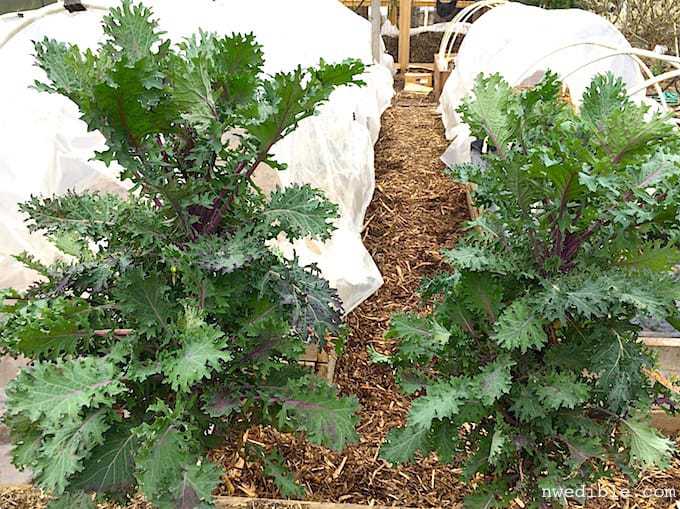
- Beets – any remaining beets should be used before they go to seed next month.
- Brussels sprouts and any remaining overwintering cabbage should be picked this month.
- Sprouting broccoli and overwintering cauliflower should be ready towards the end of this month and, depending on variety, into April or even May.
- Carrots & Parsnips – finish off any full size overwintered carrots or parsnips stored in the ground this month, they’ll go to seed soon.
- Kale & Collards – Use the shoots like broccolini.
- Sprouting Broccoli – sprouting purple should be ready to harvest late this month and into April.
- Kohlrabi – If you still have some it’s close to bolting so harvest and use.
- Chard – if your Swiss Chard has survived the winter, it will be putting on new growth now – this can be harvested until the chard finally throws a fit and insists on making seeds.
- Leeks – Probably close to sending up a seed stalk. If this happens, check the flavor and texture before consigning them to compost. I have harvested leek scapes that were sweet, mild and crunchy.
- Turnips & Rutabagas –Mine are bolting now. If you have any that aren’t, mash em up.
- Salad Greens – Mache, arugula, etc – many winter greens are lovely this time of year.
- Jerusalem Artichokes – They just….never….die.
- Stored Potatoes
- Stored Winter Squash – I have so much of this! I’m mostly roasting my Long Pie squash, making tons of pumpkin muffins and letting the kids do the rest.
- Rhubarb – I am so excited to make more rhubarb simple syrup!
How does your spring garden grow?
Share or Pin to Save This Information
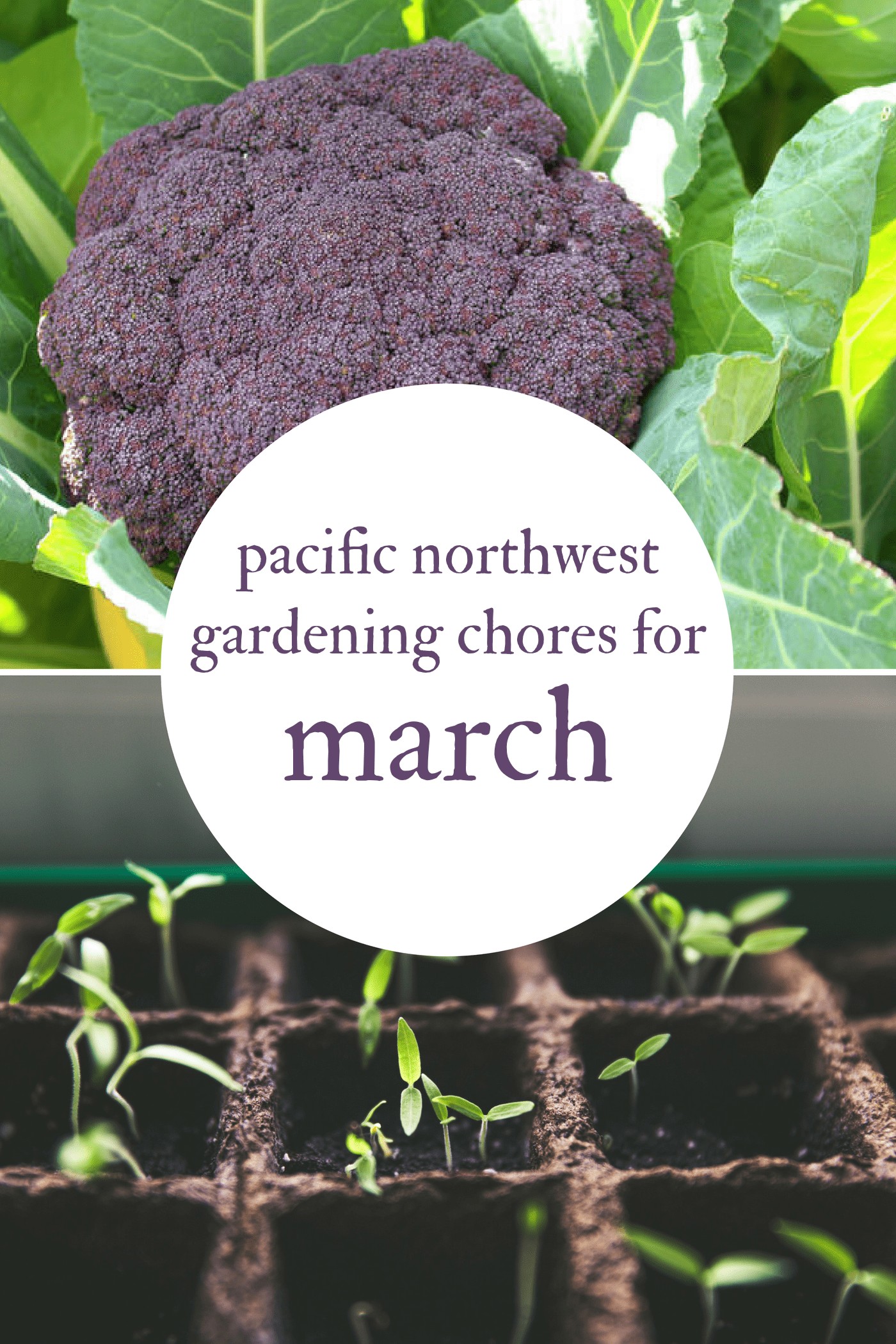
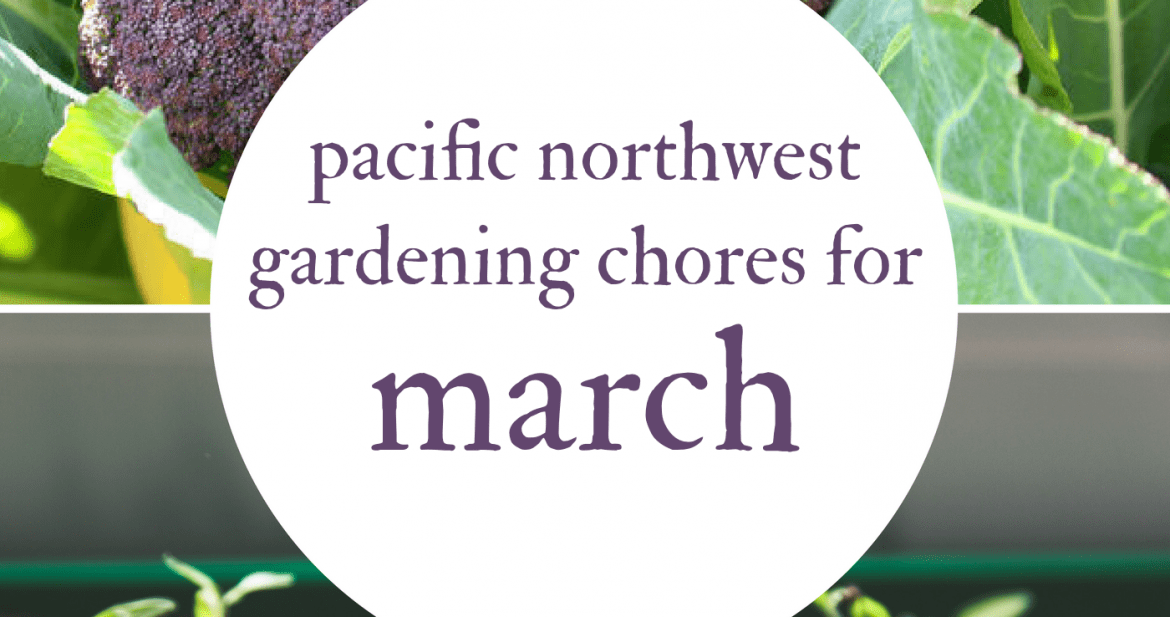
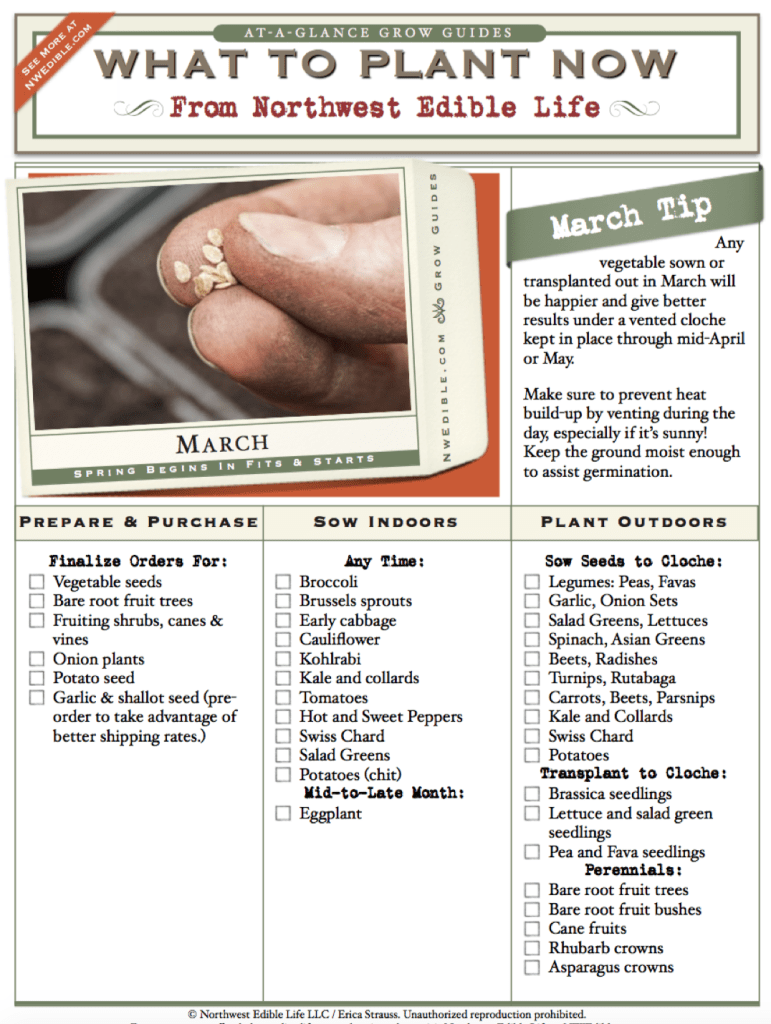
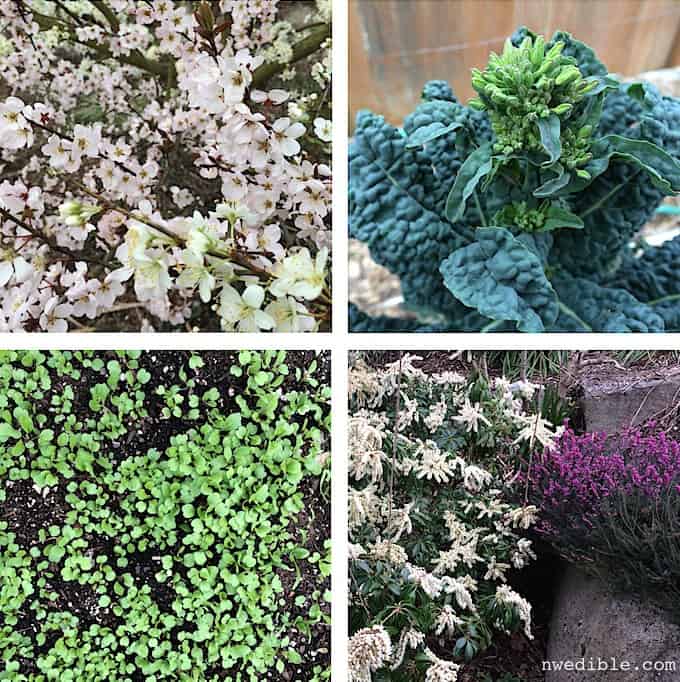


It’s supposed to freeze tonight here in south Seattle, so I’ve been running around covering my new growth with straw. I lost a bunch of anemones last year because of too much new growth and freezing. Still, I am not looking a gift spring in the mouth, my peas are up and things are popping all over. It’s like soul balm!
It has been frosty in Port Orchard whenever the sky is clear. Can you point me to some good cloches?
If you’re into DIY, clear plastic juice containers with the bottoms cut off are great. Gallon milk jugs work well too, but only at night if they’re not clear. Gardener’s Supply catalog has some nice looking cloches.
You can go with inexpensive painter’s plastic over hoops, or invest in greenhouse film for longer term use, or you can buy fabric row covers. Most well stocked nurseries should carry row cover – usually called Remay or Agribon – or you can buy it online. A mid-weight, like AG-19, should be the best for you in Port Orchard for spring and fall frost protection, and to add a bit more warmth around melons and peppers in the summer.
Depending on how big you need, I use plastic juice containers with the bottoms cut off. Protects lettuce beautifully (as long as the slugs don’t find the mini greenhouse, too!). If it’s windy you can take the juice cap off and poke a bamboo stack down through the top into the soil and that usually keeps them from blowing off. It’s no Martha Stewart, but it works and it recycles!
bamboo “stick”. sorry, I didn’t see the previous comment for the same idea.
I got some nice ones last year from the Gardener’s Supply catalog. They’re not cheap, but they should last at least 5 years, if not longer.
Hi, Erica. I really look forward to these lists, thank you! A quick question… How does sowing under lights compare with starting out in the greenhouse? We just added a greenhouse this year so I haven’t really had time to play with it yet.
Generally you go a bit later for unheated greenhouses, because they get a lot colder at night than lights in the house. But the sun is still the best grow lamp you’ve got, and seedlings that germinate in a greenhouse will be stocky and strong. If I were starting in my greenhouse at this point, I wouldn’t do tomatoes or peppers, but I would do cabbages and greens.
Tania, I start all my seeds this time of year in an unheated greenhouse without grow-lights; the key is to use heat mats to get the nice warm soil for germination. Tomatoes and peppers (along with everything else) do fine for me this way. As the starts get bigger and ambient air temperature starts to matter more, I throw a bit of row cover over them all at night, which keeps them toasty. My tomatoes are happy like this until it’s safe to plant them out under their tunnels in May.
Thanks so much for this! I’m an experienced gardener, but this is my first venture into such a mild climate (coming from zone 5!!), so I’m loving these month-by-month tips and the fact that I get to start two months earlier than usual!
Welcome to the Puget Sound, where winters are like the Southeast, and Summers are like Alaska. Your new challenge is heat units. 😉
I absolutely love the new website/blog. The header is adorable.
Thanks Erin! I’m happy with how my little doodles came out. 🙂
cloche question: I’ve already got 2 4×8′ raised beds built and filled with soil. I’ve been reading about how to build a pvc cloche, and the few sites I’ve found say it needs to be secured with pipe straps to the bed frame. Is this true if there’s already soil in there? Might the soil hold the pvc in place? I was hoping to find a cloche solution that didn’t involve any drilling.
One thing I’ve done is to poke rebar into the bed’s soil and then put the pvc onto the six or so inches of the rebar that’s sticking out of the soil, before it bends over to the other side, or in my case an upright pvc is placed over the rebar and then connected to another horizontal, and then vertical pvc piece so it’s more box shaped, than rounded. I don’t suppose anything will be as secure as pipe straps, though, especially if it’s windy and the bed is covered in a remay “sail”. We’ve used large clamps to hold the plastic onto the pvc without mishaps.
It needs to be secured. Even if the spot is sheltered from the wind normally all it takes is one gusty day and your cloche is blowing down the road. Trust me, thats not fun. The pieces of rebar like Janet suggested often work to secure the rebar, but I prefer pipe straps. If you’re planning on using covers on the bed over and over the straps don’t have to come off, just don’t screw them down tight tight so that you can slip the pipe in and out.
Personally I used 1/2″ metal “emt” electrical conduit for mine this year after the quick and dirty wooden A frame turned out to be to small. Its cheap, and although the emt bender tool was $40 I’ll be able to use it over and over to build more frames for hte garden and for chicken tractors, so it works. And unlike PVC it won’t sag under a heavy snow load if you get a late (or early) wet snow fall.
Patience Grasshopper! She lives in zone 7- Last frost is March 13! You live in Zone 5a- Last frost May 5.
2ft of snow on the ground with more on the way, I’m going to go reread “what to do in the Garden in January” while we await spring. Your post does give me hope that we may get to put away the snowblower someday soon.
quick thought/suggestion: I would love it if you did a series of short how-tos for really basic stuff. How to cure garlic and onions. How you dry beans. Your favorite ways of storing root cellar type crops without a root cellar. Easy stuff that everyone used to know. Of course, I could Google any of these kinds of questions, but I’d love to get answers/direction/solutions from a voice I trust. I imagine they would be super fast and easy for you to write and infinitely clickable.
Totally agree, I would love to see some of these types of how-to’s.
That’s a great idea, thanks!
That would be brilliant.
Tried drying beans ONCE, years ago, and half of them went mouldy. :-
I have a dehydrator now but (a) not sure if that’ll help, and (b) I’d like to know how to do it without needing a machine, if possible.
I’ve dried beans for a couple of years in a row now. The most important thing is not to let them get rained on! If my beans are out in the garden and all the foliage has turned yellow, but the weather is starting to turn, I’ll pull them all up and set them in flats in the garage to dry the rest of the way. I pretty much ignore them until the pods are really crispy, then shell and store. Often, I’ll shell them and leave them in an open bowl for a couple of weeks, stirring on occasion (so satisfying to run my fingers through all those beautiful beans!) to finish off drying just in case I have a couple that aren’t quite there yet.
Are the tomatoes pictured from this year? They look huge already! I have a grow light question: I have a fairly small operation and just want to start peppers and tomatoes. How many do you think I could start if I bought one of those grow lights? Thanks!
Your grow light looks perfect for a seed starting rack I’m trying to fashion together. I’ve got the wire shelving unit, so there’s a start! I’m curious how you hang your lights. I was thinking of using four carabiners (two to attach to the rack, the others to attach to the light) then a short stretch of chain between the carabiners. That way it’d be easy to raise/lower the chain without any sort of pulley or drawstring mechanism.
I have the same grow light and I’m using four small “s” carabiners to hook my little chain to the shelf and four equally little “s” hooks to attach the chain to the light. It’s working out very well for me! I also didn’t want to have to engineer a whole pulley system 🙂
Oh, yeah, I wouldn’t DIY a pulley system! 🙂 These ratcheting hangers are what I use. They are great. Or direct mounting with s-hooks like Christina does is fine – that’s what I did with my rack-mounted T-12s, and just put risers under the plants as I needed.
*sadface*
We have 6″ of snow covered in 1/4″ of ice. 🙁 I think I need a transplant!
Thank you for this helpful to o list! I live on the muddy end of Puget Sound in Gardening Zone who knows what, there seems to be 4 overlapping zones here. It is nice to have an experienced local just tell me when to start and what to start. Thans for blogging !
We’ve had a mild winter (so far) near Eureka, CA, and some of my indeterminate tomato plants in a cold frame are producing flowers on a few non-dead stems. I have my fingers crossed for the earliest ever tomatoes (a small comfort to drought conditions in the rest of California). Looking at my notes, it’s also time to start fertilizing fruit trees and berries and thinning the kale (I’ve planted it once 14 years ago and my lazy gardener way has meant I’ve never had to plant it again.) Thankfully the chickens love it too!
Absolutely true. Whenever we think of gardening the fear of weather comes to our mind whether it will be suitable this year to bloom our flowers. Thanks for providing insightful and useful tips while gardening. Spring is a perfect time to grow your orchids. Orchids will bloom to its best in springs. Thanks for telling the DIY process to harvesting crops. Like others orchids too depend on their root system. Orchids hold the fame as the most difficult to grow and maintain. But if correctly planted and maintained you will see beautiful orchids blooming in your garden.
About the horseradish – when we moved into our house last year I discovered a horseradish plant growing in one of the front flower beds (and nothing else – the previous owners were not gardeners). I don’t actually like horseradish, and wanted to plant something else. I have since dug the plant up three times! It is now coming up a fourth time – it can grow from even a tiny bit of root and sends big roots out sideways under other plants. You might want to dig it up and pot it – it won’t hurt the plant and it will save you from invasion! 😀
BTW – these plants are so hardy! I had a chunk of root that was sitting on my sidewalk and it started sprouting leaves! And I live in high desert, so it was doing this without water.
Hi Erica, thanks for posting this! I’m in the Midwest (Chicago area) with a slightly different climate than yours, but I’m starting to get ready for growing as well. We’re building our first raised garden bed this year, and we were able to put most of it together last weekend during 60-degree weather (and of course today it’s snowing – typical March!). I’m blogging about our experience and looking to your blog for lots of tips and info as I go. Love everything, can’t wait to read more!
Your site looks great, Laura. I can tell you guys have design background – your site is clean and easy to navigate while still being excellent on visuals. I especially like your House Tour page. Really, really nicely way to archive that material in a user friendly way. I look forward to reading more. Happy gardening!
I did my first planting of radishes in my container garden. I have two varieties from HMOS, one is the “Valentines Day” blend and the other is called D’Avignon, a longer carrot looking radish. I have two 15gal nursery containers each half planted, so I can plant more rows in two weeks for staggered harvest. I’m hoping for 4-5 harvests until it’s time for summer crops!
Thank you so much! I’ve been looking forward to these posts at the beginning of every month for about a year now. They are so helpful!
I’m so excited to finally put some of your gardening info to use this year, as we just got a p-patch plot! Hurray!!! Printing this list and eagerly looking forward to the next one! I’m in Seattle, so happily this stuff all applies to my area.
I’ve just had a mental block this spring…too many new projects. BUT, my Raintree nursery order arrived and I somehow got suckered into trying out an aronia….I believe I have YOU to blame for that. 😉
But, having box full of new trees and shrubs has finally got my gardening blood flowing!
Oh, that rhubarb!
I’ve got rhubarb transplant from the (very English) fathers of both my partners in my raised beds, and I’m praying that my weird (maybe not that weird) winter of sudden,significant melts followed by -40 with not enough snow cover (the bed is mostly sheltered by a canoe, but I don’t know if that’s helping or hindering here) hasn’t killed them off. :-
It’s still quite snowy up here, though not as bad as we were thinking it would be this time last week. The temperatures are climbing above freezing int he next few days, though, so Spring may actually be arriving. Looking forward to seeing my peppermint, grek Oregano, sage, sunchokes, and (fingers crossed) rhubarb & Vietnamese Garlic coming up in another 4-6 weeks!
I just seeded my onion seeds in pots a week ago. I have used West Coast Seeds coastal planting chart for the Puget Sound area and find it very appropriate for our climate. It’s a great graphic and you can often get it on nice card stock if you ask . It’s nice for people that like to touch paper!
Thanks fro the printable! Almost done with planning my garden, Found here some great ideas and new veggies to add to my plan. Definitely recommending your post to some friends! Greets!
Erica, and members
Even tho The Dalles is included in the PNW garden zone designations
it has some peculiarities that set it a little apart. Are there gardeners
among you that live in, or near, The Dalles? If so, would you be interested
in sharing experience and information with a relative newbie to the food
gardening scene here?
This is a delightful site, useful, informative and fun. I am so pleased to
have found it. Thank you, Erica, for creating nwedible.com
My unheated, unattached garage is the only place I can start seeds. If I use grow lights and a heated mat, can I still start seedlings in there, or is that too cold?
That’s exactly how I do it. In the Pac NW it doesn’t get super duper cold, so if you are in the Midwest or Northeast your experience might be different – but my experience is a heat mat, lights and an unheated garage work wonderfully.
Oh perfect. I’m in SeaTac, so if it works for you, it should work for me.
I’m beginning to realize that I started my tomatoes waaaaaaay the hell too early…as in early last month (February)! I live in the north of France so our conditions are kinda like yours and I have no idea what possessed me to start them so soon…now manically thinking about where on earth I am going to put them (more precisely, where in yard/patio as gorgeous glass greenhouse is yet a twinkle in mine eye) come mid-April when they’re slowly taking over every last bit of space in my office closet…
My bestie just said I probably overdid it because I’m expecting my first baby. Most people nest indoors, I guess I just do it outside…BABY NEEDS FRESH TOMATOES STAT!
Thanks for the great site, love it for years now. Cheers from Normandy
Oh just the name Normandy makes me happy…between the WWII history, the food (the calvados! the butter!) and the amazing countryside it’s one of my favorite places in the world.
As far as your tomatoes go, I have started mine in early February and you will be okay. Just put them in bigger and bigger pots if you need, and don’t be tempted to set them out too early if nights are still chilly. I shall play a cliche and assume you have some big old stone wall somewhere (because that’s how I imagine every place in Normandy…acres of buildings and fences build of stacked stone) – if you can plant your tomatoes on the south side of a stone wall you’ll buy yourself at least a couple weeks.
One final thought…when I was pregnant with my first child I painted my bathtub sky blue with clouds. We are all to be forgiven for flights of lovely fancy when expecting. Congrats!
Thanks for the reply! I didn’t see it until now, but it’s very nice of you. GOD I WISH I had a big old stone wall—preferably several. Attached to big old stone houses, and those attached to a bank account that could afford to renovate them all…le sigh. Someday. For the moment, we’re in a very nice ‘pavillon’ which is basically a 1960s ‘burbs house. There is some local rock on the bottom level which makes the house look like it belongs in a Flintstone episode…but my (French) husband was real excited about it. “LOOK HONEY LOCAL ROCKS!”
Anywho, we do have a fab view of all the beautiful houses in our teeny tiny town and more importantly we have a south-facing wall…a Flintstone wall…but still a wall. I’ll be popping those tomato suckers down there in early May, and then off to the (as-yet unconstructed) raised beds mid-month.
Normandy is one of my favorite places on earth, too. Right when I first moved here, I got serious soul-feels. Which is the only good reason to live someplace this damp….!
Funny about the bathtubs—right about when I first found out I was pregnant, I was seriously considering buying a sky-blue cast iron bathtub to redo. Must be something about that color and the idea of happy baths that appeals to the pregnant brain…
Cheers!
Hey, Erica! What a fantastic post! That is such a detailed article, with so much great info! Thanks!